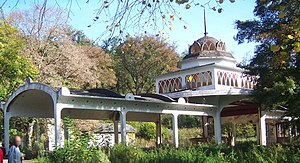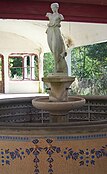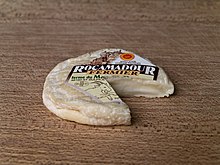Alvignac
| Alvignac | ||
|---|---|---|

|
|
|
| region | Occitania | |
| Department | Lot | |
| Arrondissement | Gourdon | |
| Canton | Gramat | |
| Community association | Causses et Vallée de la Dordogne | |
| Coordinates | 44 ° 50 ′ N , 1 ° 42 ′ E | |
| height | 249-419 m | |
| surface | 13.05 km 2 | |
| Residents | 720 (January 1, 2017) | |
| Population density | 55 inhabitants / km 2 | |
| Post Code | 46500 | |
| INSEE code | 46003 | |
| Website | www.alvignac.fr | |
 The Pavillon des Eaux source Salmière in Alvignac |
||
Alvignac (unofficially Alvignac les Eaux ) is a French commune with 720 inhabitants (as of January 1, 2017) in the Lot department in the Occitanie region (before 2016: Midi-Pyrénées ). The municipality belongs to the arrondissement of Gourdon and the canton of Gramat .
The current name of the municipality is derived from the name Albiniacum fundum (country estate of Albinius or Alvinius) from Gallo-Roman times .
The inhabitants are called Alvignacois and Alvignacoises .
geography
Alvignac is located about 27 kilometers northeast of Gourdon and about six kilometers northeast of Rocamadour in the historic province of Quercy in the Causses du Quercy Regional Nature Park .
Alvignac is surrounded by the five neighboring municipalities:
| Montvalent | Miers | |
| Rocamadour |

|
Thégra |
| Rignac |
Alvignac is located in the Dordogne river basin .
The Ruisseau de Cazelle rises on the territory of the municipality, crosses it from southeast to northwest and leaves the surface in the shaft cave Roque de Cor on the territory of the neighboring municipality of Montvalent. Another shaft cave, Gouffre de Réveillon , is located in the municipality and collects the water of the Ruisseau de Salgues. The subterranean geography of the area is interspersed with shaft caves and grottos .
The landscape of the municipality is diverse: walnut trees , pasture land, chestnuts , limestone plateaus overgrown with juniper and agricultural fields.
history
The first human traces are found in numerous dolmens and barrows in the northwest of the municipality. The scientists Michel Carrière and Jean Clottes report five dolmens and around twenty barrows in the area. Most of them were excavated by the archaeologists André Niederlender and Amédée Lemozi in 1911.
Between 1801 and 1806 the municipality of Salgues was incorporated.
The history of the parish follows that of Quercy with its vicissitudes, the Hundred Years War , the Huguenot Wars and the French Revolution . According to legend, the discovery of the Source Salmière medicinal spring in Alvignac goes back to the beginning of the Christian era. The first investigations date back to the 17th century and subsequently came the spa guests, including famous personalities such as Madame de Pompadour . The heyday of the spa were the 19th and 20th centuries with more than 3000 spa guests annually. In the course of time the interest in spa stays waned, so that the operation was closed in 1981.
Population development
At the beginning of the 19th century the population rose to a high of around 935. In the following period the size of the community decreased, but reached a relative high in the middle of the 19th century of around 780. A longer period of stagnation began until to the 1930s. At the turn of the millennium, a growth phase set in that continues to this day.
| year | 1962 | 1968 | 1975 | 1982 | 1990 | 1999 | 2006 | 2011 | 2017 |
|---|---|---|---|---|---|---|---|---|---|
| Residents | 534 | 540 | 525 | 566 | 473 | 573 | 632 | 731 | 720 |
Attractions
Parish church of Sainte-Marie-Madeleine
The Bishop of Cahors Géraud (1068-1083) donated several churches to the priory of Carennac , including those of Rignac and Alvignac, which was a branch of Rignac. The masonry bond of small rubble stones in two large arches in the second yoke inside the nave indicates a date to the 11th century. On the other side of the leaves ogival history suggests a later date of origin. Today's church is largely a new building at the end of the 15th or beginning of the 16th century. The bell tower and aisles were restored in the late 15th century style in 1880 and 1886. The stained glass windows date from 1887.
The church has a square apse and a nave with a length of four bays of different sizes. The two aisles are two bays long. The square bell tower is built on the outside north at the western end of the church building. The main nave and the western bays of the side aisles are equipped with a false ribbed vault , so that the impression is created as if the side aisles were originally side chapels .
Cantocor Castle
In the 15th century, the fief was in the possession of the Seigneurs von Miers, vassals of the Turenne vice-county . In 1566 it was bought by François de Tanes, Seigneur von Salgues, now a hamlet of Alvignac, and passed through marriage to the Céré family. The nobleman Alexandre de Géniés married Gabrielle de Céré in 1644. In 1723 the Géniés family sold Cantocor to Antoine de Fontanges. In 1764 Madame de Pompadour lived in the castle during her spa stay.
In 1787 the doctor Étienne Clédel bought the castle. During the French Revolution he was a member of the département in the National Convention and lived there until his death in 1820. The property came into the hands of the Bergougnoux family, who have kept it to this day. At the end of the 19th century it became the center of a farm. Only an examination of the building could identify relics from the Middle Ages on the building. The distinctive three towers are no older than the late 16th century and could have been built by François de Tanes. In the south, another small round tower is attached to the round wall. At the southern corner of the residential wing, a square tower has kept a cantilever latrine. Its plastering prevents an in-depth analysis from the outside. A thick, round tower made of quarry stones is attached to the east corner of the residential wing.
Salgues Castle
A Roger de Salgues is mentioned in a document in 1097 on the occasion of a return of land to the monastery of Tulle. A Rigaud de Salgues is mentioned in 1286 as co-seigneur of Miers, Pierre de de Salgues in 1320. The manorial power went from the Salgues family to the Bormes family, because the noble Jean de Bormes was mentioned in 1360 as seigneur of Salgues. In 1589 the manor went to the Plas de Tanes family, who held it until the French Revolution. In Jare 1830, the notary Molinier lived in the castle, which he owned at the time. Today it still belongs to descendants of the Molinier family.
The tower could come from the 13th century, as well as part of the residential wing, which was extensively rebuilt in the 16th or 17th century, as well as new modifications, presumably in the 19th century. A square, slightly raised pavilion is covered with a mansard roof. The approximately eight meter wide tower is made of ashlar , originally practically without wall openings. A light opening just above the surface of the earth indicates a basement. An entrance door that was on the first floor on the south side was replaced by a window. A simple wall connects the tower with the L-shaped residential wing. An entrance with a soffit and framed in a pointed arch at the level of the first floor has been bricked up in a shapeless manner. In one wall of the stairwell there is an ogival door.
Source Salmière
It is located north of Alvignac in the neighboring municipality of Miers, southeast of the Lac de la Source . The spring water comes from an aquifer that was formed in the Lower Jurassic . In 1962 a borehole with a diameter of 125 mm and a depth of 48 m increased the flow from 0.1 to 15 m³ per hour. The water was then directed to the bottling plant and the Pavillon des Eaux . The bottles produced are sold in pharmacies and health food stores. Alvignac-Miers sodium sulfate water has beneficial effects on digestive and urinary tract diseases.
Most of the buildings to receive the spa guests were built at the beginning of the 19th century and are still visible today:
- The Pavillon des Eaux , built from 1904 to 1906 in thin-walled concrete architecture ( Hennebique technique), has the shape of a pagoda on the outside . In the center under a dome stood a reproduction of the statue by Antonio Canova , which represented the goddess Hebe . Unfortunately, this statue was stolen in February 2010. A circular room allowed spa guests to put their cups down and drink the spring water
- The building protecting the borehole from 1962
- The source building
- The “bouillon kiosk”, an open rotunda with a concrete structure and traditional beams. There, the spa guests drank a herbal broth in addition to the spring water
- The Grand Hotel built in the 1920s
- The bottling plant
- A balcony building above the lake. It was used as a nightclub in the 1980s and a restaurant more recently. A thermal bath was opened in 1911 and had its peak at the beginning of the last century. Closed since 1981.
Economy and Infrastructure
Alvignac is in the AOC zones of Noix du Périgord , Périgord walnuts, Périgord nut oil and Rocamadour , a goat's milk cheese .

total = 110
education
The community has
- a public preschool and elementary school with 51 students in the school year 2018/2019 and
- the private preschool and primary school Notre-Dame with 5 students in the school year 2018/2019.
traffic
Alvignac can be reached via Routes départementales 20, 673, the former Route nationale 673 and 840, the former Route nationale 140 .
A line of the TER Occitanie , a regional train of the national SNCF , serves the route from Brive-la-Gaillarde to Figeac , which crosses the area of the municipality in the extreme north. A stop called “Rocamadour – Padirac” is located in the area of the neighboring municipality of Rocamadour.
Web links
- Website of the Causses du Quercy Regional Nature Park (French)
- Information on Périgord walnuts and Périgord nut oil (French)
- Information about the Rocamadour cheese (French)
Individual evidence
- ^ Jean-Marie Cassagne: Villes et Villages en pays lotois ( fr ) Tertium éditions. S. 10. 2013. Retrieved May 18, 2019.
- ↑ Nom des communes et paysage ( fr , PDF) Parc naturel régional Causses du Quercy. Retrieved May 18, 2019.
- ↑ Lot ( fr ) habitants.fr. Retrieved May 18, 2019.
- ↑ a b La Mairie ( fr ) Alvignac municipality. Retrieved May 18, 2019.
- ↑ Michel Carrière, Jean Clottes: Le dolmen du Pech n ° 1 à Alvignac (Lot) ( fr ) In: Gallia Préhistoire . Persée. 1970. Retrieved May 18, 2019.
- ↑ a b Notice Communale Alvignac ( fr ) EHESS . Retrieved May 18, 2019.
- ↑ Histoire et Patrimoine ( fr ) Municipality of Alvignac. Retrieved May 18, 2019.
- ↑ Populations légales 2016 Commune d'Alvignac (46003) ( fr ) INSEE . Retrieved May 18, 2019.
- ↑ Gilles Séraphin, Maurice SCELLES: église paroissiale Sainte-Marie-Madeleine ( fr ) Départemental Lot. October 3, 2013. Retrieved May 18, 2019.
- ↑ Gilles Séraphin, Maurice SCELLES: château ( fr ) Départemental Lot. January 2, 2015. Retrieved May 18, 2019.
- ↑ Château de Cantocor ( fr ) chateau-fort-manoir-chateau.eu. Retrieved May 18, 2019.
- ↑ Gilles Séraphin, Maurice SCELLES: château ( fr ) Départemental Lot. January 2, 2015. Retrieved May 18, 2019.
- ↑ Château de Salgues ( fr ) chateau-fort-manoir-chateau.eu. Retrieved May 18, 2019.
- ↑ La Source Salmière ( fr ) Alvignac municipality. Retrieved May 18, 2019.
- ↑ Institut national de l'origine et de la qualité: Rechercher un produit ( fr ) Institut national de l'origine et de la qualité . Retrieved May 18, 2019.
- ↑ Caractéristiques des établissements en 2015 Commune d'Alvignac (46003) ( fr ) INSEE . Retrieved May 18, 2019.
- ^ École maternelle et élémentaire ( fr ) National Ministry of Education. Retrieved May 18, 2019.
- ^ École maternelle et élémentaire ( fr ) National Ministry of Education. Retrieved May 18, 2019.






